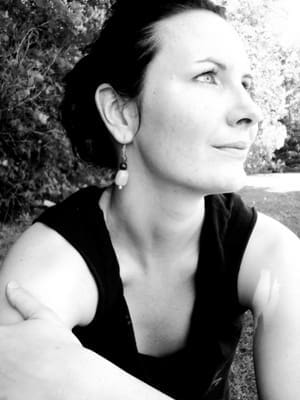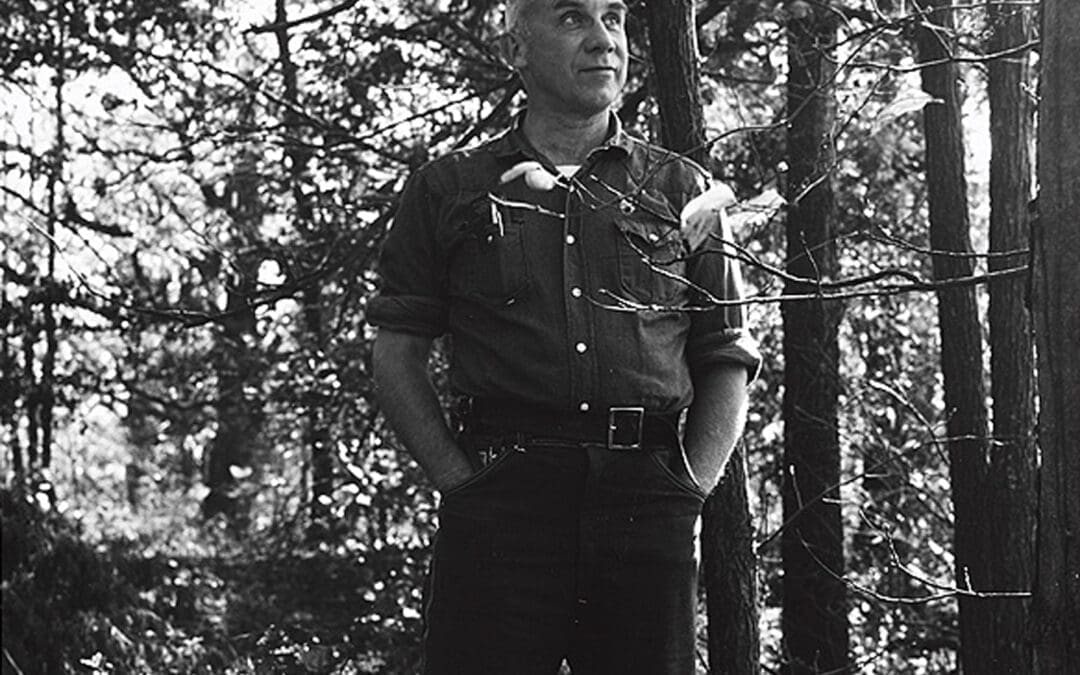An interview with encaustic artist Shannon Newby, exploring the integration of her craft in the everyday, and the delights and comforts that make living and creating worthwhile.
The first thing you notice about Shannon and Erik Newby is their sincerity, and then, their interconnectedness.
Tucked into a small basement apartment in southeast Vancouver, the husband and wife duo have made the temporary space their own. Erik’s design office is in the living room corner—two screens and requisite earphones to tune out the pounding of three little pairs of feet upstairs. Shannon’s encaustic paintings sit on shelves and tables and are scattered across the windowsills. Her studio is out back, cherry-red toddler bikes littering the way. On the cream-coloured walls they’ve used egg-shell-toned contact paper to carve out images and carefully selected fonts—a subtle white on white. A couple of dancing paper airplanes trace their course above the couch where I sit. The front door signals its regret as you pass through outside: Goodbye. It’s a lovely home brimming with creative minutiae.
I find myself visiting on a rainy April day as the result of a chance meeting at a letter-writing party earlier this spring. While the rest of us tip-tapped on typewriters, Shannon caught my interest as she wiled away on a little paper scroll project.
 |
Originally from Indianapolis, Shannon always wanted to be an artist “when she grew up” and her parents encouraged her art-making. “My favorite Christmas gift growing up was a set of Bob Ross oil paints,” she reflects, sitting at her kitchen table. “I went through a season where I stapled or nailed everything to the wall. I’d change it weekly as inspiration hit. One day it’d be southern paraphernalia strapped to the wall—the next, the parts of my disassembled bike. My first installation pieces, you could say! Even in elementary school, I was working to incorporate different elements into my art.”
But when she got older—as with many of us—the expectations changed and she was told she’d need to make sure “to have a back-up plan.” She completed her undergrad in Christian Education and Studio Art at Taylor University where she wrote her senior thesis on the integration of Christianity and the arts.
“As I was writing the paper, I realized I wanted nothing more than for the integrated arts ministry I was dreaming of to be real. At the time, Erik and I were dating and wondering what God would have in store for us next.”
They married, and while Erik was working on freelance web design projects, Shannon began to pursue art more seriously, creating part time and looking for opportunities to exhibit and sell her work. After the first year she was able to transition into working as a full-time artist.
Back in Shannon’s kitchen I discover that encaustic art wasn’t her first choice. As a child, she dreamed of animating twenty-first century sleeping beauties for Disney; as a teenager she’d planned on a career in interior design. It wasn’t until 2006 that she arrived at the hot wax appliqués of encaustic art.
“I had the privilege of taking an encaustic class at Ball State University and, like most who try their hand at it, I immediately became obsessed. Up to that point, I had not really been “sold” on any one medium. Working with oils was tiresome—I don’t have the patience!—and I wanted to do a lot with mixed media, which didn’t seem compatible with what I was trying to do with oil painting. Acrylic colors weren’t as vibrant as the oil paints, and while the acrylic gel medium allowed me to do more with mixed media, it still wasn’t the look I was hoping for. Beeswax was my happy medium—it meant I could mix in oil paints and get rich, deep colors, and the tackiness and pliability of the beeswax allowed me to incorporate mixed media without having to add another medium into the process.”
“I think I was pretty much sold on day one when I learned you had to use a heat gun or blow-torch to fuse the wax. My blow-torch and I have been inseparable ever since—going on four years now!”
Encaustics (also known as hot wax painting) involves using heated beeswax coloured with pigments. The liquid is applied to a surface—usually prepared wood—and manipulated with metal tools and brushes. Today, heat guns allow artists to extend the amount of time they have to work with the quick-binding material. Materials such as paper and found objects can be collaged onto the surface or layered inside, using the encaustic medium to adhere it to the surface. It is an archival medium that can last for centuries. In fact, the oldest known encaustic images are more than 2,000 years old.
 |
Today, in preparation for full-time arts work with Greater Europe Mission, Shannon is learning about marketplace and business-as-missions models at Regent College while Erik works with GemStone Media—a company that provides resources like print materials, websites, and short videos for churches and missionaries within Europe. Upon completion of Shannon’s master’s degree, they’ll leave for the small southwest town of Kamdern, Germany, where a 25,000 square foot abandoned building (they’re calling it the “Art Factory”) is currently being renovated into a community art centre, complete with classes and workshops in various art mediums, space for artists’ studios, an artist-in-residence program, a large exhibition space, and a coffee shop. Here Shannon will work as a studio artist, teaching and being an advocate for others as they learn to be culture makers, while sharing the hope of Christ.
Between a full class schedule at Regent College, directed studies with prominent encaustic artist and Trinity Western University professor Erica Grimm-Vance, and overseas ministry commitments, Shannon creates her art—which increasingly leans toward installation work—in the garage of their rented house.
Shannon’s current collection is titled “By Its Cover.” More sculptural in nature, her new work attempts to deconstruct old books, push boundaries, explore stereotypes, and give antiquated objects new life. What was once a book shelved neatly in a library and flipped through for knowledge can now be seen as a purely aesthetic element, permanently embedded in thick raw beeswax. It is an exploration in dismantling the familiar. This series consists of fragile brown book pages dipped in wax, elaborate book covers neatly decorated with embossed patterns, and thick, raw beeswax poured around the outer edges to seal it all in.
I spoke with the busy artist a week before co-hosting an encaustics workshop at the Grunewald Guild in Leavenworth, Washington, about the delights, comforts, and some of the challenge of her archival medium.
 |
Christina Crook: Can you describe for us the process involved in creating one of your pieces?
Shannon Newby: The process requires working with melted “encaustic medium”—a combination of beeswax and a hardening agent. I take the beeswax (often raw beeswax straight from a beekeeper) and put it into a large pot, set it on my hot plate, and turn up the temperature to around 220º Fahrenheit. I temper my wax with carnauba flakes (although many encaustic artists will use damar resin or microcrystalline wax, combined with the beeswax). Encaustic painting is a process of heating and cooling the surface, so I take the heated wax and apply it to my substrate (or in many cases, I will dip things—like book pages—directly in my pot of hot wax). After every layer, I “fuse”—I reintroduce heat to the now-cooled wax. My heat source of choice is definitely a blowtorch, although many encaustic artists use heat guns or irons. So I use a blowtorch to “fuse” each layer—which allows the wax to bind itself to each preceding layer. This is done to ensure the piece will be archival. When I want to use color, I will add dry earth pigments, oil paints, or oil sticks to the encaustic medium. In all my work in the last eight months, however, I have been more interested in the raw medium (golden yellow) and have not used any pigments.
CC: How does your faith inform your work?
SN: This is a good question. How does it not inform my work? I pray that everything I put my hands to would be informed by my relationship with Christ. I have never painted a cross (although I am not opposed to doing so,) but my work has always been a form of exegesis: an exercise in interpreting Scripture, interpreting my faith in Jesus, into visual form.
CC: What does the encaustic medium mean to you and what do you love most about it?
SN: I love the earthiness of it. Encaustic painting is the most ancient and archival paint form we know of; ancient Egyptians were using it as early as A.D. 50—that’s right around the time that Paul wrote I and II Thessalonians on his second missionary journey! Some days when I’m working in the studio, I think about that and wonder if there were any encaustic painters that were trying to paint a literal portrait of Jesus, or any of his disciples. (It’s not that far-fetched of a thought!) And of course, using beeswax, a raw, organic material to begin with, is tremendously satisfying.
 |
CC: What are the delights of this medium? (And, perhaps, some the challenges?)
SN: Hands-down, this medium is delightful because of its versatility. It’s such a unique medium to paint, dig, scrape, melt, dip, sculpt. One of the challenges is in keeping the temperature of my work regulated. In order for the work to be archival (and potentially be preserved for thousands of years), it has to maintain a normal temperature range. That is, the environment shouldn’t be too hot (100º F) because it could melt, nor should it get too cold (below 40º F) because it could get brittle and chip. That can be a challenge when figuring out how to transport and ship a work, but for the most part, it’s a non-issue. The benefits far outweigh any challenges.
CC: What are the comforts of working as an encaustic artist?
SN: Knowing that I’m working with an earthy, organic material that has been around since God created bees is a comfort. I love teaching encaustics classes because students find the medium very comforting and satisfying to work with. It’s very forgiving—you can make a “mistake” and scrape it or melt it off and just start over. I’ve had students with a watercolor background get excited about the translucency of the wax and dream up pieces on rice paper adhered to glass with a beautiful effect, and then I’ve had others with a pottery background get excited about using their pottery tools to scrape into the wax, while the oil painters in the group get enamored with the compatibility of their medium with the wax.

